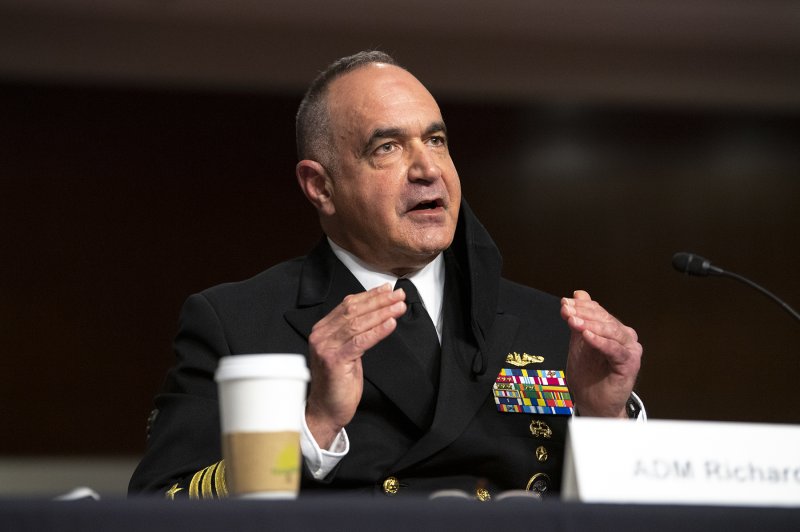STRATCOM commander Adm. Charles A. Richard, pictured last month testifying before the Senate Armed Services Committee, said Thursday he'd like to see a smaller role for nuclear weapons by the U.S., China and Russia. Photo by EJ Hersom/Department of Defense
May 6 (UPI) -- The commander of U.S. Strategic Command said Thursday that he'd like to see a reduced role for nuclear weapons by the United States, Russia and China -- and would like to extend the olive branch to both.
Speaking virtually at the Center for Strategic and International Studies Project on Nuclear Issues Capstone Conference, Navy Adm. Charles A. Richard said that, for the first time in history, the United States faces two aggressive nuclear-capable peer competitors at the same time.
But before the U.S. can extend the olive branch, STRATCOM is focused on achieving a safe, effective and credible nuclear deterrent, Richard said.
That's because China is rapidly working to expand its stockpile, and Russia is making aggressive efforts to modernize its nuclear weapons program.
"As a nation, we have not had to consider the implications of engaging in competition through possible crisis or direct armed conflict with a nuclear-capable adversary in nearly three decades," Richard said, according to a Pentagon press release.
"Now, for the first time in our history, we face two nuclear-capable strategic peer competitors at the same time," Richard said.
China's strategic and conventional forces are rapidly expanding, and the country could double its nuclear stockpile by the end of the decade, Richard said.
Richard, whose assessment of China's nuclear capability echoes a Pentagon report released last fall, made similar comments at a Senate Armed Services Committee budget hearing last month.
On Thursday, Richard said the size of a nuclear stockpile is "a very crude measure of its overall strategic capability."
Threat assessments also need to factor in delivery systems, accuracy, command and control, readiness, posture, doctrine and training, Richard said.
Richard described an extensive Russian nuclear modernization program, which he estimates to be about 80% complete, though the Kremlin has said it's actually 88% complete.
Russia has a number of novel weapon systems that include a nuclear-armed missile mounted on a hyperglide system and a nuclear-armed underwater drone, according to Richard.
He also said Russia and China are far outpacing the U.S. in producing science, technology, engineering and math graduate degree holders.
According to Richard, STRATCOM's workforce is aging and the command is in need of talented, young scientists, software developers, engineers and technologists.
The U.S. Navy Blue Angels perform at The Great Florida Air Show presented by Northrup Grumman in Melbourne, Fla., on Saturday. Photo by Joe Marino/UPI |
License Photo
















